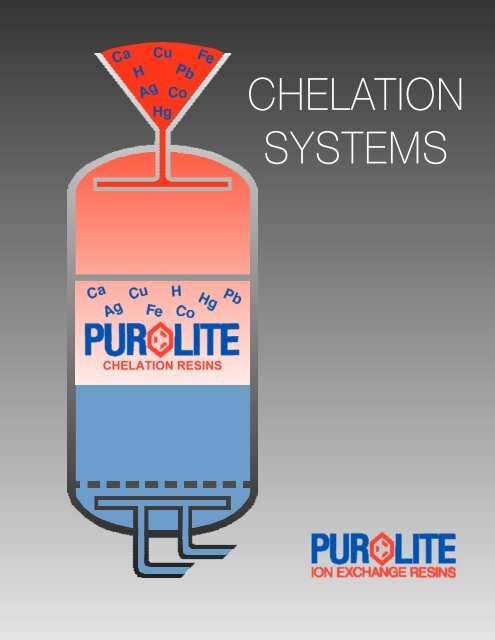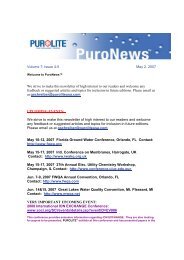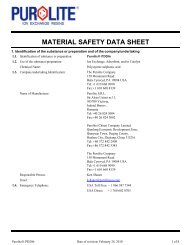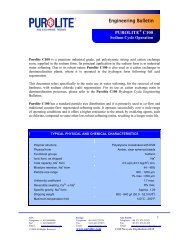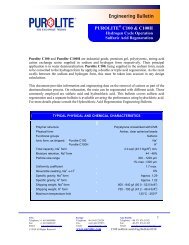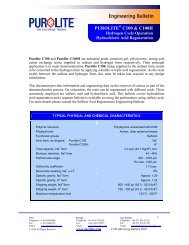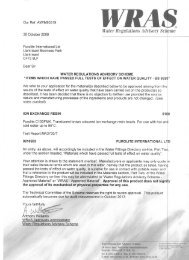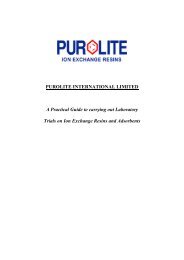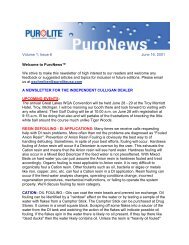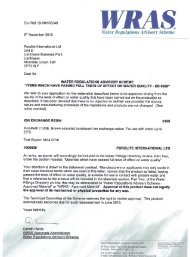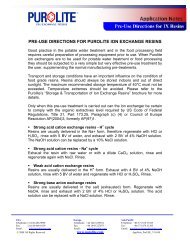You also want an ePaper? Increase the reach of your titles
YUMPU automatically turns print PDFs into web optimized ePapers that Google loves.
Cu<br />
Hg<br />
CHELATION RESINS<br />
C H E L AT I O N<br />
S Y S T E M S
Section 1. INTRODUCTION<br />
The removal of metals from process liquors<br />
is rapidly gaining in importance. The<br />
escalating costs of disposal of waste<br />
solutions, in order that they <strong>com</strong>ply with<br />
increasingly tough regulation, have to be<br />
taken into account. Such costs have to be<br />
considered in conjunction with possible<br />
savings to be made from recovery.<br />
<strong>Purolite</strong> offers a range of chelation resins<br />
which will selectively remove particular<br />
groups of metals from solution. After<br />
preliminary recovery by precipitation, on the<br />
one hand, or where plated metal objects<br />
have been given final rinses, on the other<br />
hand, these metals are usually present in<br />
waste solutions in concentrations of several<br />
parts per million. Such concentrations<br />
although low are found to be environmentally<br />
harmful In many cases.<br />
The use of <strong>Purolite</strong> Chelation Resins f o r<br />
the purification of these waste aqueous<br />
streams to render them suitable for disposal<br />
through the domestic sewerage system, or<br />
direct disposal into suitable aquifers, affords<br />
a most suitable and economical means of<br />
treatment, which yields treated solutions<br />
containing almost undetectable (ppb)<br />
concentrations of the undesirable metals.<br />
The many-fold increase in concentration of<br />
the metals on the chelation resin makes<br />
Section II.<br />
Resin Type Functional Group Matrix<br />
<strong>Purolite</strong><br />
S-<strong>920</strong> Thiouronium Macroporous<br />
styrene-divinylbenzene<br />
S-930 Iminodiacetic Macroporous<br />
styrene-divinylbenzene<br />
S-940 Aminophosphonic Macroporous<br />
styrene-divinylbenzene<br />
S-950 Aminophosphonic Macroporous<br />
styrene-divinylbenzene<br />
1<br />
Chelation Systems<br />
Technical Data<br />
possible the recovery of the metal for<br />
reprocessing or effective disposal in a less<br />
harmful form.<br />
Modern industrial chemical processes often<br />
use sophisticated techniques which provide<br />
a more economical route to high quality<br />
products. One such process uses<br />
membrane cells for the electrolysis of brine<br />
to produce caustic soda and chlorine. The<br />
membrane cells require that the inlet brine<br />
contains less than 20ppb of calcium for<br />
efficient operation. <strong>Purolite</strong> S -940 provides<br />
an ideal route to reduce calcium<br />
concentration in brine feed solutions from 1-<br />
15ppm, as found in conventionally purified<br />
solutions, to well within the required<br />
specification, for the smooth operation of<br />
this process.<br />
As analytical techniques continue to<br />
improve, the study of the effect of trace<br />
levels of impurities on the economics of<br />
industrial processes is increasingly well<br />
understood. The very high selectivity of<br />
chelation resins means that these ion<br />
exchange resins will offer many further<br />
possibilities to remove harmful<br />
contaminants to provide solutions of the<br />
required purity.<br />
Principal Applications<br />
Mercury and precious metals removal<br />
from aqueous solutions<br />
Effluent treatment, hydrometallurgy<br />
(Specific for heavy metals)<br />
Brine purification<br />
(Removal of calcium etc)<br />
Effluent treatment<br />
Hydrometallurgy
Contents<br />
Section II. Page Nos.<br />
I. INTRODUCTION Chelation Systems 1<br />
II. SUMMARY CHART 1<br />
III. PUROLITE S-<strong>920</strong> For the selective removal of mercury 3<br />
and precious metals from aqueous solutions.<br />
Product Description<br />
Standard Operating Conditions<br />
Principle of reaction<br />
Hydraulic Characteristics<br />
Operating Performance<br />
IV. PUROLITE S-930 For the selective removal of heavy metals. 7<br />
Product Description<br />
Standard Operating Conditions<br />
Principle of reaction<br />
Applications Operating Performance<br />
Hydraulic Characteristics<br />
V. PUROLITE S-940 Especially for decalcification of brine solution. 11<br />
Product Description<br />
Operating Conditions-Brine purification<br />
Principles of Operation<br />
Principal Application<br />
Operating Performance<br />
Chemical and Physical Stability<br />
General Applications<br />
Hydraulic Characteristics (General Applications)<br />
Pressure drop and backwash expansion<br />
(Brine purification)<br />
VI. PUROLITE S-950 For selective removal of toxic metals from 17<br />
aqueous solutions.<br />
Product Description<br />
Standard Operating Conditions<br />
Chemical Stability<br />
Hydraulic Characteristics<br />
Affinity order of typical cations<br />
Applications<br />
Operating Performances<br />
VII. COMMENTS 21<br />
2
<strong>Purolite</strong> S-<strong>920</strong> is a macroporous<br />
polystyrenic based chelating resin, with<br />
thiouronium groups designed for the<br />
selective removal of mercury.and for the<br />
recovery of precious metals from the<br />
industrial effluents. The mercury, in<br />
particular, is strongly bound to the functional<br />
groups to form highly stable <strong>com</strong>plexes,<br />
with high selective affinity <strong>com</strong>pared with<br />
those of other heavy metals. These<br />
properties are largely unaffected by high<br />
chloride (or sulphate) content of the<br />
effluent. Effluent solutions which may<br />
typically contain 2-20ppm of mercury can be<br />
treated to reduce the concentration in<br />
solution to less than 0.005ppm. P u r o l i t e<br />
S-<strong>920</strong> can load up to 200g of mercury, or<br />
gold, or 60g approx. of platinum or<br />
palladium for each litre of resin, equivalent<br />
to 12.5, and 3.75 Ib/ft 3 respectively. <strong>Purolite</strong><br />
S-<strong>920</strong> is designed for the removal of low<br />
Technical Data<br />
Section III. PRODUCT DESCRIPTION<br />
Typical Chemical & Physical Characteristics<br />
3<br />
S-<strong>920</strong><br />
Macroporous Thiouronium<br />
Chelating Resin<br />
(For the selective removal of mercury and<br />
precious metals from aqueous solutions)<br />
concentrations of soluble mercury salts<br />
from waste streams and for the recovery of<br />
precious metals from rinse waters in the<br />
galvanic and electronic industries. P u r o l i t e<br />
S-9 2 0 is also used in hydrometallurgy for<br />
the separation of precious metals from acid<br />
liquors. Mercury and precious metals are so<br />
strongly held, and run lengths are so long<br />
(thousands of hours) that it is not normally<br />
considered economic to regenerate the<br />
resin for reuse.<br />
<strong>Purolite</strong> S-<strong>920</strong> is more resistant to<br />
oxidation than many thiol based resins and<br />
contact with the atmosphere is not<br />
detrimental, however free chlorine and<br />
other strong oxidising agents may damage<br />
the resin and their removal from solution by<br />
filtering through activated carbon is<br />
re<strong>com</strong>mended.<br />
Polymer Matrix Structure ..................................... Macroporous Styrene-divinylbenzene<br />
Physical form & Appearance ..................................................... Opaque Cream Spheres<br />
Whole Bead Count ................................................................................................ >95%<br />
Functional Groups ....................................................................................... Thiouronium<br />
Ionic Form (as shipped) .............................................................................................. H +<br />
Shipping Weight .................................................................... 700 - 735 g/l (44 - 46 lb/ft 3 )<br />
Screen Size range (British Standard Screen) ........................................ 14-52 mesh, wet<br />
Particle Size range ............................................................ + 1.2mm
It is re<strong>com</strong>mended that <strong>Purolite</strong> S-<strong>920</strong> i s<br />
used in a two column, lead and trail system.<br />
In this way, maximum loading of the resin is<br />
achieved. When use is for mercury uptake,<br />
it is usual to pretreat the solution with lime<br />
The mercury is strongly <strong>com</strong>plexed by the<br />
sulphur and nitrogen groups. When the<br />
resin is well rinsed with water before use,<br />
the mercury salt as a whole is<br />
ac<strong>com</strong>modated on the resin. In most<br />
instances the pH of the water to be treated<br />
will lie in the range of 3-10, which is<br />
generally very suitable for highest mercury<br />
uptake and the lowest leakage - typically<br />
STANDARD OPERATING CONDITIONS<br />
PRINCIPLE OF REACTION<br />
HYDRAULIC CHARACTERISTICS<br />
4<br />
neutralisation and to fully oxidise the metals<br />
and sulphites with H2O2. This is followed by<br />
flocculation with an inorganic polyelectrolite,<br />
sedimentation, sand and activated carbon<br />
filtration .<br />
Re<strong>com</strong>mended linear flow rate: 6-18 m/h<br />
Minimum bed depth: 1000mm<br />
Backwash flow rate: 4-8 m/h (see fig. 2), for 20 min.<br />
Mercury Removal<br />
NH2<br />
RCH2 S C + Hg ++ Cl2 Hg S C<br />
NH<br />
The pressure drop (or headloss) across a<br />
properly classified bed of ion-e x c h a n g e<br />
resin depends on the particle size<br />
distribution, bed depth, and voids volume of<br />
the exchange material, and on the flowrate<br />
and viscosity (and hence on the<br />
temperature) of the influent solution.<br />
Anything affecting any of these parameters,<br />
for example the presence of a particulate<br />
matter filtered out by the bed, abnormal<br />
<strong>com</strong>paction of the resin bed, or the<br />
RCH2<br />
N + H2 Cl -<br />
N + H Cl -<br />
much less than 5ppb as Hg. pH may be<br />
reduced slightly by the mercury exchange<br />
(release of acid held by the weakly basic<br />
thiouronium groups) .<br />
In general <strong>Purolite</strong> S- 9 2 0 will <strong>com</strong>plex<br />
precious metals when they are present as<br />
free cations. The free cation state is<br />
governed by the pH of the solution.<br />
in<strong>com</strong>plete classification of the bed will<br />
have an adverse effect, and result in an<br />
increased headloss.<br />
Service flow rates from 10-30 bed volumes<br />
per hour, depending on the application, may<br />
be regarded as the normal range used on<br />
this resin. Typical pressure drop figures to<br />
be expected for ordinary aqueous solutions,<br />
are given in Fig. 1.
Fig. 1. PRESSURE DROP VS FLOW RATE Fig. 2. BACKWASH EXPANSION<br />
(New resin)<br />
1 . 0<br />
0 . 8<br />
0 . 6<br />
0 . 4<br />
0 . 2<br />
FLOWRATE U.S. gpm/ft 2<br />
8 1 6 2 4<br />
0 2 0 4 0 6 0<br />
FLOWRATE m/h<br />
During upflow backwash, the resin bed<br />
should be expanded in volume by between<br />
50 and 75%, to clear the bed of bubbles and<br />
voids, and to classify the resin particles as<br />
much as possible, ensuring minimum<br />
resistance to flow. Bed expansion increases<br />
The operating capacity will be higher on the<br />
first cycle since both lead and trail columns<br />
will use new resin. This cycle will be<br />
<strong>com</strong>plete when the lead column is<br />
saturated (that is when influent and effluent<br />
have reached equilibrium). The substantial<br />
leakage which occurs from the lead column<br />
towards the end of the cycle is of course<br />
taken out by the trail column. This uses<br />
capacity depending upon the conditions of<br />
operation. In subsequent runs the<br />
throughput obtained from the lead column<br />
4 -<br />
3 -<br />
2 -<br />
1 -<br />
CONVERSION OF UNITS<br />
OPERATING PERFORMANCE<br />
5<br />
with flow rate and decreases with<br />
temperature, as shown in Fig. 2. This applies<br />
to unused resin. Since the resin is not<br />
regenerated, backwash at exhaustion is not<br />
required. Care should always be taken to<br />
avoid resin loss by over-expansion of the bed.<br />
1 m/h (cubic metres per square metre per hour) = 0.341 gpm./ft 2 .<br />
= 0.409 U.S. gpm./ft 2 .<br />
1Kg/cm 2 /m (Kilograms per square cm. per metre of bed) = 4.33 psi/ft.<br />
= 1.03 atm./m<br />
= 10 ft. H 2 O/ft<br />
1 0 0<br />
5 0<br />
FLOWRATE U.S. gpm/ft 2<br />
2 4 6<br />
0 5 1 0 1 5 2 0<br />
FLOWRATE m/h<br />
will be reduced according to load previously<br />
taken up while the bed was in the trail<br />
position.<br />
The Fig. 3. gives a typical exhaustion profile<br />
from the outlet of the trail column in terms<br />
of bed volumes throughput for the lead<br />
column. In a typical operation as shown the<br />
lead column is loaded with a total of 90g/l of<br />
mercury of which 70-85g/l may be loaded<br />
while the bed is in the lead position.
Fig. 3. OPERATING PROFILE: Typical from trail column<br />
2 0<br />
1 5<br />
1 0<br />
5<br />
0<br />
THROUGHPUT g a l / m i n / f t 3 x 1000<br />
2 . 5 5<br />
1 0 2 0 3 0 4 0 5 0<br />
THROUGHPUT BED VOLUMES X 1,000<br />
(For lead column)<br />
6<br />
Inlet Mercury — 2ppm<br />
to Lead Column<br />
Temperature 20°C<br />
pH 8.0<br />
Flow Rate 8BV/h<br />
* Leakage values may be lower<br />
in dotted line region
<strong>Purolite</strong> S-930 is a macroporous<br />
polystyrene based chelating resin, with<br />
iminodiacetic groups designed for the<br />
removal of cations of heavy metals from<br />
industrial effluents. These cations may be<br />
separated from high concentrations of<br />
univalent cations (typically sodium) and also<br />
from <strong>com</strong>mon divalent cations (such as<br />
calcium). Removal can be achieved both<br />
from weakly acidic and weakly basic<br />
solutions depending on the metals to be<br />
removed.<br />
Technical Data<br />
Section IV. PRODUCT DESCRIPTION<br />
Typical Chemical & Physical Characteristics<br />
7<br />
S-930<br />
Macroporous Iminodiacetic<br />
Chelating Resin<br />
(For the selective removal of heavy metals from<br />
aqueous solutions)<br />
<strong>Purolite</strong> S-930 finds use in processes for<br />
extraction and recovery of metals from<br />
ores, galvanic plating solutions, pickling<br />
baths, and effluents even in the presence<br />
of alkaline earth metals (calcium and<br />
magnesium).<br />
Further important uses include the refining<br />
of the salt solutions of transition and<br />
precious metals and for the cleaning and<br />
purification of various organic or inorganic<br />
chemical products by removal of heavy<br />
metals contamination (usually from<br />
aqueous solution).<br />
Polymer Matrix Structure ..................................... Macroporous Styrene-divinylbenzene<br />
Physical form & Appearance ...................................................... Opaque Beige Spheres<br />
Whole Bead Count ................................................................................................ >90%<br />
Functional Groups ...................................................................................... Iminodiacetic<br />
Ionic Form (as shipped) ............................................................................................. Na +<br />
Shipping Weight .............................................................. 710 - 745 g/l (44.5 - 46.5 lb/ft 3 )<br />
Screen Size range (British Standard Screen) ........................................ 14-52 mesh, wet<br />
Particle Size range .......................................................... + 1.0mm
<strong>Purolite</strong> S-930 :- These operating conditions<br />
are given as a general example.<br />
However regeneration conditions and<br />
flow rates should be chosen for the<br />
The iminodiacetic functional groups, in<br />
either the sodium or the hydrogen form, will<br />
chelate heavy metals by ion attraction to the<br />
<strong>Purolite</strong> S -930 is particularly suitable for the<br />
removal of heavy metals (as weakly acidic<br />
chelated <strong>com</strong>plexes) which are held<br />
according to the following order of<br />
STANDARD OPERATING CONDITIONS<br />
Operation Rate Solution Minutes Amount<br />
Service 8 - 16BV/h For treatment<br />
1-2gpm/ft 3<br />
Backwash 5-7m/h Raw Water 5-20 1.5-6BV/h<br />
2-3gpm/ft 2 10-35 gal/ft 3<br />
Regeneration 3-4BV/h Mineral Acids 30-60 140-200g/l HCL or<br />
0.4-0.5gpm/ft 3 (2N-3N) 12.5-20lb/ft 3<br />
PRINCIPLE OF REACTION<br />
APPLICATIONS<br />
8<br />
200-320g/l H2SO4<br />
Slow rinse 3-4BV/h Raw Water 30-40 2-3BV/h<br />
0.4-0.5gpm/ft 3 15-25gal/ft 3<br />
Conversion to sodium form as required:-<br />
3-4BV/h 1 /2 N NaOH 40-60 40-60g/l<br />
0.4-0.5gpm/ft 3 (Upflow)* 2.5-3.75lb/ft 3<br />
Rinse 3-4BV/h Soft or Demin 20-40 2-4BV/h<br />
0.4-0.5gpm/ft 3 Water 15-30gal/ft 3<br />
Backwash expansion 75% (optimum)<br />
Design rising space 100%<br />
Minimum bed depth 1000m<br />
"gallons refer to U.S. gallons = 3.785 Litres.<br />
particular application. For further<br />
re<strong>com</strong>mendations please contact your<br />
local sales office<br />
*The aim is to achieve the same pH as that of the in<strong>com</strong>ing solution.<br />
R - - -CH2 - - -N<br />
CH2 - - -C = O<br />
ONa<br />
ONa<br />
CH2 - - -C = O<br />
+ M 2+<br />
dicarboxylic functionality and electron<br />
donation from the nitrogen:<br />
R - - -CH2 - - -N<br />
CH2 - - -C = O<br />
CH2 - - -C = O<br />
M + 2Na +<br />
O<br />
O<br />
selectivity.<br />
Cu>>Ni>Zn≥Co≥Cd>Fe(ll)>Mn>Ca<br />
The macroporous resin structure ensures<br />
excellent diffusion of ions thus affording
efficient exhaustion and regeneration.<br />
Recovery of heavy metals from effluents<br />
from the plating industry is achieved by<br />
concentration and is particularly useful<br />
where full demineralisation and recycling of<br />
the rinse water is not practised. The<br />
simplest case is where only one heavy<br />
metal is present, when volumes of rinse<br />
water are low, waste water fees may be<br />
low, and raw water has a low salt content.<br />
<strong>Purolite</strong> S-930 can be used to reduce<br />
residual toxic heavy metals to below the<br />
maximum admissible concentration levels<br />
which are often far below those obtainable<br />
after precipitation reactions. It may also be<br />
used to remove similar residuals from<br />
The information below may be taken as a<br />
general guide. However, before any plant<br />
design is contemplated, the user should<br />
ascertain the exact operating performance<br />
under the proposed conditions of use, by<br />
way of column testing of the feed solution<br />
to be treated.<br />
The operating capacity is a function of pH ,<br />
Fig. 1. Exchange capacity for metals<br />
as a function of pH.<br />
2 5<br />
2 0<br />
1 5<br />
1 0<br />
5<br />
0<br />
1 2 3 4 5<br />
pH<br />
OPERATING PERFORMANCE<br />
9<br />
demineralised rinse water circuits.<br />
<strong>Purolite</strong> S -930 is also used to separate and<br />
concentrate heavy metals in hydrometallurgical<br />
processes (ore dressing and<br />
scrap recovery). It is particularly suitable<br />
where metals are present in low<br />
concentrations. Separation techniques may<br />
be carried out according to the order of<br />
selectivity given above. However changes<br />
in the sequence occur with change in pH<br />
and in the presence of certain anions<br />
(including higher concentrations of chloride<br />
and sulphate). The sequence given above is<br />
applicable for neutral and weakly acidic<br />
solutions.<br />
and inlet concentration solution for each<br />
metal. Fig. 1 gives the exchange capacity<br />
obtainable when using the operating<br />
conditions given above, as a function of pH.<br />
This capacity is a function of ionic<br />
concentration, hence the multiplication<br />
factor given in fig. 2 should be applied.<br />
HYDRAULIC CHARACTERISTICS (General Applications)<br />
The pressure drop (or headloss) across a<br />
properly classified bed of ion-e x c h a n g e<br />
resin depends on the particle size<br />
distribution, bed depth, and voids volume of<br />
the exchange material, and on the flow rate<br />
and viscosity (and hence on the<br />
C u<br />
N i<br />
F e<br />
Fig. 2. Correction factor for ionic<br />
concentration<br />
1 . 5<br />
1 . 0<br />
0 . 5<br />
IONIC CONCENTRATION %<br />
1 2 3 4 5<br />
IONIC CONCENTRATION g/l<br />
temperature) of the influent solution.<br />
Anything affecting any of these parameters,<br />
for example the presence of particulate<br />
matter filtered out by the bed, abnormal<br />
<strong>com</strong>paction of the resin bed, or the<br />
in<strong>com</strong>plete classification of the bed will
have an adverse effect, and result in an<br />
increased headloss. Service flow rates from<br />
8-16 bed volumes per hour, 1-2gpm/ft 3 ,<br />
depending on the application, may be<br />
regarded as the normal range used on this<br />
resin.<br />
During upflow backwash, the resin bed<br />
should be expanded in volume by between<br />
50 and 75%, in order to free it from any<br />
particulate matter from the influent solution,<br />
to clear the bed of bubbles and voids, and<br />
to reclassify the resin particles as much as<br />
10<br />
Typical pressure drop figures to be<br />
expected for ordinary aqueous solutions,<br />
are given in fig. 3., below. This is applicable<br />
to the freshly regenerated H + Form. As the<br />
resin is converted to the metal form the<br />
pressure drop will decrease slightly.<br />
Fig. 3 PRESSURE DROP VS. FLOWRATE Fig. 4 BACKWASH EXPANSION<br />
(Exhausted Form)<br />
1 . 0<br />
0 . 8<br />
0 . 6<br />
0 . 4<br />
0 . 2<br />
FLOWRATE U.S. gpm/ft 2<br />
8 1 6 2 4 3 2<br />
0 2 0 4 0 6 0 8 0<br />
FLOWRATE m/h<br />
4 -<br />
3 -<br />
2 -<br />
1 -<br />
CONVERSION OF UNITS<br />
FLOWRATE U.S. gpm/ft 2<br />
2 4 6 8<br />
0 5 1 0 1 5 2 0<br />
FLOWRATE m/h<br />
possible, ensuring minimum resistance to<br />
f l o w. Bed expansion increases with flow<br />
rate and decreases with temperature, as<br />
shown in fig. 4, for a typical exhausted form<br />
of the resin. Care should always be taken to<br />
avoid resin loss by over-expansion of the<br />
bed.<br />
1 m/h (cubic metres per square metre per hour) = 0.341 gpm./ft 2 .<br />
= 0.409 U.S. gpm./ft 2 .<br />
1Kg/cm 2 /m (Kilograms per square cm. per metre of bed) = 4.33 psi/ft.<br />
= 1.03 atm./m/<br />
= 10 ft. H 2 O/ft<br />
1 0 0<br />
5 0
Section V. PRODUCT DESCRIPTION<br />
<strong>Purolite</strong> S-940 is a chelating resin of<br />
macroporous structure, with a polystyrene<br />
matrix crosslinked with divinylbenzene<br />
(DVB) substituted with weakly acidic<br />
aminophosphonic active groups. This<br />
chemical structure facilitates the formation<br />
of <strong>com</strong>plexes with metallic ions. The<br />
aminophosphonic chelating resins have a<br />
NOTE: <strong>Purolite</strong> S-940 is susceptible to<br />
oxidation. Hence direct treatment of brine<br />
solutions containing free chlorine should be<br />
avoided, for instance by preliminary reaction<br />
with sulphur dioxide, sulphite or, by use of a<br />
treatment with activated carbon. Brine<br />
solution can often contain significant<br />
Technical Data<br />
Typical Chemical & Physical Characteristics<br />
11<br />
S-940<br />
Macroporous Aminophosphonic<br />
Chelating Resin<br />
(Especially for decalcification of<br />
brine solutions)<br />
greater affinity for certain cations, and form<br />
more stable <strong>com</strong>plexes with cations of low<br />
atomic mass metals than their iminodiacetic<br />
resin counterparts. Hence <strong>Purolite</strong> S -940 is<br />
capable of fixing one or more specific<br />
cations from a larger range even from<br />
solutions which are highly concentrated.<br />
Polymer Matrix Structure ..................................... Macroporous Styrene-divinylbenzene<br />
Physical form & Appearance ..................................................... Opaque Cream Spheres<br />
Whole Bead Count ................................................................................................ >95%<br />
Functional Groups .................................................................................. -CH 2 NHCH 2 PO 3<br />
Ionic Form (as shipped) ............................................................................................. Na+<br />
Shipping Weight ...............................................................710 - 745 g/l (44.5 - 46.5 lb/ft 3 )<br />
Screen Size Range<br />
(British Standard Screen) ........................................................ 18-36 mesh<br />
(U.S. Standard Screen) ........................................................... 20-40 mesh<br />
Particle Size range ...................................................... + 0.85mm
<strong>Purolite</strong> S-940 may also be used in the<br />
hydrogen form for heavy metals removal.<br />
The above operating conditions may be<br />
adapted as follows. The regeneration is<br />
carried out using HCI, as above (or 2N<br />
H2S O4 may also be used at 200-300g/l;<br />
1 2 . 5-1 9 l b / f t 3 ). The objective of the sodium<br />
The capacity of this resin is dependent upon<br />
pH; it is able to operate in neutral, acidic or<br />
alkaline media, however the relative<br />
affinities for metals vary as a function of pH<br />
and ionic concentration, hence it is<br />
PRINCIPLES OF OPERATION<br />
- Acidic pH<br />
Pb2+ > Cu2+ > U4+ , Zn2+ , Al3+ >Mg2 + > Sr2 + , Ca2 + , Na + 2 + , Ba<br />
-Alkaline pH<br />
Cd 2+ Mg 2+ > Ca 2+ > Sr 2+ Al 3+ > Ba 2+ > , Na + K +<br />
STANDARD OPERATING CONDITIONS<br />
Operation Rate Solution Minutes Amount (Temp)<br />
Service 8-30BV/h<br />
1-4gpm/ft<br />
Brine * 1.25 * (at 60—90°C)<br />
3<br />
Relative<br />
Volume<br />
Change<br />
Brine Displacement 4 BV/h Soft water 60—90 1.30 4—6BV (room<br />
temp, RT)<br />
0.5gpm/ft 3 30—45 gals /ft 3<br />
Backwash 8-12m/h Soft water 30 - - (RT)<br />
3-5 gpm/ft 2<br />
Regeneration 2-6BV/h HCI (Normal) 30-60 1.0 100-150g/l (RT)<br />
0.25-0.75gpm/ft 3 6.25-9.5 Ib/ft 3<br />
Rinse 2-4BV/h Soft water 30-60 1.0 2BV(RT)<br />
0.25-0.5gpm/ft 3 1 5gal/ft 3<br />
Sodium Conversion 2-4BV/h NaOH (Normal) 15-60 1.45 20-80g/l (RT)<br />
0.25-0.5 gpm/ft 3 (Upflow) 1.25-5 Ib/ft 3<br />
Rinse 2-4BV/h Soft water 30-60 1.45 2BV (RT)<br />
0.25-0.5 gpm/ft 3 15 gal/ft 3<br />
* Exhaustion time and volume of treated brine depend upon the operating conditions<br />
(see Figures 1-4) “gallons” refer to US gallons =3.785 litres<br />
12<br />
conversion is to optimise the pH of solution<br />
to maximise capacity and reduce leakage.<br />
The aim should be to achieve the same pH<br />
as that of the in<strong>com</strong>ing solution. Operation<br />
flow rates of 8-16 BV/h (1-2 gpm/ft 3 ) may be<br />
used, and displacement prior to backwash<br />
eliminated or modified.<br />
re<strong>com</strong>mended that laboratory trials (column<br />
tests) are carried out to prove the process.<br />
The list of relative affinities will help serve<br />
as guide in such trials.<br />
In the particular case of brine purification by softening the feed solution of chloralkali<br />
electrolysis cells, the characteristic reactions are described as follows:—<br />
-Service<br />
2RCH2NH CH2PO3 Na2 + Ca 2 + (RCH2NH CH2PO3 )2 CaNa2 .<br />
- Regeneration to H+ form<br />
(RCH2NH CH2PO3)2 CaNa2 + 4HCI 2RCH2NH CH2PO3 H2 + CaCI2 + 2NaCI<br />
-Conversion to sodium form<br />
RCH2NH CH2PO3H2 + 2Na OH RCH2NH CH2PO3Na2 + 2H20
The various applications of <strong>Purolite</strong> S- 9 4 0<br />
are too numerous to cover individually in<br />
detail. Brine softening is the major<br />
application. Chlorine gas and alkali metal<br />
hydroxides are produced by the electrolysis<br />
of brine solutions in chlor-alkali cells. The<br />
industrial process has used three main<br />
types of these cells - m e r c u r y, diaphragm,<br />
and membrane electrolytic cells. The<br />
membrane cells are the most economic and<br />
are supported by the most sophisticated<br />
technology in their operation. All types need<br />
periodic maintenance as a result of the<br />
impurities in the brine, especially Ca and<br />
Mg. Membrane cells require the highest<br />
purity brine which should contain less than<br />
20ppb calcium and less than 50-100ppb Sr<br />
according to the process specification.<br />
PRINCIPLE APPLICATION<br />
OPERATING PERFORMANCE<br />
13<br />
<strong>Purolite</strong> S-940 is sufficiently selective for<br />
strontium to allow for its containment in the<br />
polishing column when the lead column is<br />
operated to a calcium leakage endpoint.<br />
This applies for Sr values up to 20% of the<br />
feed Ca concentration by weight.<br />
In this way it is possible to operate at a<br />
steady lower voltage, thus saving energy<br />
and increasing production.<br />
Purification of brine (removal of divalent and<br />
trivalent cations) to the exacting standards<br />
required is achieved by using P u r o l i t e<br />
S-940 which will remove the majority of<br />
contaminant metals, even under very<br />
difficult conditions: saturated salt (more<br />
than 300g/l of NaCI), alkaline pH, elevated<br />
temperature.<br />
The operating capacity expressed in g Ca 2 + per litre increases with:<br />
- pH, optimum >9 (see fig. 1 )<br />
- influent calcium concentration, (see correction factor in fig. 2)<br />
- temperature of feed, which is best maintained at above 60°C (see fig. 3)<br />
- Reduction in flow rate, (see fig. 4)<br />
10-20BV/h is re<strong>com</strong>mended, though rates up to 30BV/h are feasible.<br />
The permanent leakage obtained in treating<br />
brine using <strong>Purolite</strong> S -940 is generally very<br />
Low: for example < 50ppb for strontium<br />
Fig. 1 CAPACITY FOR CALCIUM REMOVAL<br />
(as a function of pH)<br />
2 5<br />
2 0<br />
1 5<br />
1 0<br />
5<br />
7 8 9 1 0 1 1 1 2<br />
pH<br />
and < 20ppb for calcium and magnesium,<br />
see fig. 5 and 6.<br />
Fig. 2 CORRECTION FACTOR FOR<br />
INFLUENT CALCIUM CONCENTRATION<br />
1 . 2<br />
1 . 1<br />
1 . 0<br />
0 . 9<br />
0 . 8<br />
0 . 7<br />
0 5 1 0 1 5 2 0 2 5<br />
CALCIUM INFLUENT CONCENTRATION ppm
1 . 1<br />
1 . 0<br />
0 . 9<br />
0 . 8<br />
0 . 7<br />
0 . 6<br />
Fig. 3 CORRECTION FACTOR FOR<br />
TEMPERATURE<br />
TEMPERATURE °F<br />
1 2 0 1 3 0 1 4 0 1 5 0<br />
5 0 6 0 7 0<br />
TEMPERATURE °C<br />
Fig. 5 TYPICAL LEAKAGE OF CALCIUM<br />
5 0<br />
4 0<br />
3 0<br />
2 0<br />
1 0<br />
0<br />
THROUGHPUT gal/ft 3<br />
5 0 1 0 0 1 5 0<br />
Influent Ca + + 1 5 p p m<br />
Temperature 60°C, 140°F<br />
pH 10<br />
5 0 0 1 0 0 0<br />
THROUGHPUT - BED VOLUMES<br />
<strong>Purolite</strong> S-940 has been exhaustively<br />
tested to demonstrate that it will withstand<br />
temperatures above the maximum<br />
re<strong>com</strong>mended limit of 90°C (194°F) in the<br />
presence of brine solutions at high ionic<br />
concentration (300g/l). It has also been<br />
shown that <strong>Purolite</strong> S-940 is both<br />
chemically and physically stable to high<br />
concentrations of acid and alkali (20% of<br />
sulphuric acid and 20% of sodium<br />
CHEMICAL AND PHYSICAL STABILITY<br />
14<br />
Fig. 4 CORRECTION FACTOR FOR FLOW<br />
RATE<br />
g a l / m i n / f t 3<br />
8 0 1 6 0 2 4 0 3 2 0 4 0 0<br />
1 0 2 0 3 0 4 0<br />
FLOWRATE BV/h<br />
hydroxide), which are stronger than would<br />
normally be used under the most severe<br />
conditions of operation. In tests for osmotic<br />
and physical stability using a specially<br />
developed rig* which incorporates<br />
mechanical stress and attrition, by pumping<br />
the resin against a retaining stainless steel<br />
mesh, the following results were typically<br />
obtained after 100 cycles of operation.<br />
Resin % Perfect % Cracks % Pieces % Mis shapes<br />
<strong>Purolite</strong> S-940 97 1 1 1<br />
<strong>Purolite</strong> S-940 100 cycles 96 0 2 1<br />
* Test Rig originally developed by the Scientific Services Division of the Electricity Generating Board of UK.<br />
1 . 0<br />
0 . 8<br />
0 . 6<br />
0 . 4<br />
0 . 2<br />
1 0 0<br />
Fig. 6 TYPICAL LEAKAGE OF Mixed<br />
CATIONS<br />
THROUGHPUT gal/ft 3<br />
5 0 1 0 0 1 5 0<br />
Influent Ca + + 6 p p m<br />
S r + + 4 p p m<br />
Temperature 60°C, 140°F<br />
pH 10.5<br />
Flow rate 30BV/h<br />
S r + +<br />
C a + +<br />
5 0 0 1 0 0 0<br />
THROUGHPUT - BED VOLUMES
<strong>Purolite</strong> S-940 is also suitable for<br />
separation and recovery of heavy metals,<br />
including uranium. The leakage of uranium<br />
can depend on linear flow rate in the resin<br />
in pulp process (see Fig. 7).<br />
- <strong>Purolite</strong> S-940 has a high selectivity for<br />
heavy metals and transition metals, more<br />
p a r t i c u l a r l y, lead, copper and zinc. The<br />
affinity for copper is higher than for zinc and<br />
hence it is possible to separate and<br />
concentrate these metals from a mixture in<br />
solution.<br />
- <strong>Purolite</strong> S-940 may be used to purify<br />
solutions. For example, lead can be<br />
removed from industrial waste streams<br />
etc...<br />
The pressure drop (or headloss) across a<br />
properly classified bed of ion-e x c h a n g e<br />
resin depends on the particle size<br />
distribution, bed depth, and voids volume of<br />
the exchange material, and on the flowrate<br />
and viscosity (and hence on the<br />
temperature) of the influent solution.<br />
Anything affecting any of these parameters,<br />
for example the presence of particulate<br />
matter filtered out by the bed, abnormal<br />
GENERAL APPLICATIONS<br />
HYDRAULIC CHARACTERISTICS<br />
15<br />
<strong>com</strong>paction of the bed, or the in<strong>com</strong>plete<br />
classification of the bed will have an<br />
adverse effect, and result in an increased<br />
headloss.<br />
Service flow rates from 10-30 bed volumes<br />
per hour depending on the application, may<br />
be regarded as the normal range used on<br />
this resin. Typical pressure drop figures to<br />
be expected for ordinary aqueous solutions,<br />
are given in fig. 8 below.<br />
Fig. 8 PRESSURE DROP VS FLOWRATE Fig. 9 BACKWASH EXPANSION<br />
(Exhausted Forms)<br />
1 . 0<br />
0 . 8<br />
0 . 6<br />
0 . 4<br />
0 . 2<br />
FLOWRATE U.S. gpm/ft 2<br />
8 1 6 2 4<br />
0 2 0 4 0 6 0<br />
FLOWRATE m/h<br />
4 -<br />
3 -<br />
2 -<br />
1 -<br />
Fig. 7 EXTRACTION OF URANIUM<br />
7 0<br />
6 0<br />
5 0<br />
4 0<br />
3 0<br />
2 0<br />
1 0<br />
1 0 0<br />
5 0<br />
FLOWRATE U.S. gpm/ft 2<br />
2 4 4 9 7 4 9 8 1 2 3<br />
0 6 0 1 2 0 1 8 0 2 4 0 3 0 0<br />
FLOWRATE m/h<br />
FLOWRATE U.S. gpm/ft 2<br />
2 4 6 8<br />
0 5 1 0 1 5 2 0<br />
FLOWRATE m/h<br />
I n f l u e n t : -<br />
U 4 = 40ppm<br />
F e 2 = 8 g/l<br />
P 2O 5 = 28%<br />
Flow Rate<br />
= 6 BV/h
During upflow backwash, the resin bed<br />
should be expanded in volume between 50<br />
and 75%, in order to free it from any<br />
particulate matter from the influent solution,<br />
to clear the bed of bubbles and voids, and<br />
to reclassify the resin particles as much as<br />
The pressure drop across a bed of resin<br />
when brine (300g/l) is the influent solution is<br />
considerably higher than that for more dilute<br />
solutions hence the curves given below<br />
should be used, see fig. 10.<br />
Brine purification<br />
PRESSURE DROP AND BACKWASH<br />
16<br />
possible, ensuring minimum resistance to<br />
f l o w. Bed expansion increases with flow<br />
rate and decreases with temperature, as<br />
shown in fig. 9 for a typical exhausted form<br />
of the resin. Care should always be taken to<br />
avoid resin loss by over-expansion of the<br />
bed.<br />
The backwash expansion for the calcium<br />
form resin at the end of the brine<br />
purification is higher than that for the<br />
heavier metals, thus the curves in fig. 11<br />
are applicable<br />
Fig. 10 PRESSURE DROP VS FLOWRATE Fig. 11 BACKWASH EXPANSION<br />
1 . 0<br />
0 . 8<br />
0 . 6<br />
0 . 4<br />
0 . 2<br />
FLOWRATE U.S. gpm/ft 2<br />
8 1 6 2 4 3 2<br />
0 2 0 4 0 6 0 8 0<br />
FLOWRATE m/h<br />
40°C , 104°F<br />
60°C , 140°F<br />
80°C , 176°F<br />
4 -<br />
3 -<br />
2 -<br />
1 -<br />
1 0 0<br />
5 0<br />
FLOWRATE U.S. gpm/ft 2<br />
2 4 6 8<br />
0 5 1 0 1 5 2 0<br />
FLOWRATE m/h
<strong>Purolite</strong> S-950 is a macroporous aminophosphonic<br />
acid chelating resin, designed<br />
for the removal of cations of toxic metals<br />
such as lead, copper and zinc from industrial<br />
effluents at low ph. At somewhat higher pH<br />
values, calcium, magnesium and barium, as<br />
well as the toxic metals cadmium, nickel,<br />
and cobalt are strongly <strong>com</strong>plexed and may<br />
be separated from quite high concentrations<br />
of univalent cations.<br />
Unlike <strong>Purolite</strong> S-930, the well known<br />
iminodiacetic acid resin, which is selective<br />
Technical Data<br />
Section VI. PRODUCT DESCRIPTION<br />
Typical Chemical & Physical Characteristics<br />
17<br />
S-950<br />
Macroporous Aminophosphonic<br />
Chelating Resin<br />
(For the selective removal of toxic metals<br />
from aqueous solutions)<br />
for heavy metal ions, but not for <strong>com</strong>mon<br />
divalent ions (calcium and magnesium),<br />
<strong>Purolite</strong> S-950 is more highly selective<br />
(under the appropriate conditions) for a<br />
range of both heavy metal and <strong>com</strong>mon<br />
divalent ions. Hence its use may be<br />
re<strong>com</strong>mended where it is necessary to<br />
remove calcium or magnesium in order to<br />
avoid possible precipitation, or where its<br />
selectivity for a particular range of metals<br />
offers advantages.<br />
Polymer Matrix Structure ................................Macroporous Styrene-divinylbenzene<br />
Physical Form & Appearance ........................................Opaque light brown spheres<br />
Whole Bead Count ............................................................................................>95%<br />
Functional Groups ..........................................................................RCH2 N HCH2 P03<br />
ionic Form (as shipped) ........................................................................................Na +<br />
Shipping Weight g/l ...................................................710 - 745 g/l (44.5 - 46.5(lb./ft 3 ))<br />
Screen Size Range: British Standard Screen ...................................14-52 mesh, wet<br />
U.S. Standard Screen .......................................16-50 mesh wet<br />
Particle Size Range .......................................................+1.2mm
<strong>Purolite</strong> S -950 is insoluble in acids, alkalies<br />
and all <strong>com</strong>mon solvents at normally<br />
encountered temperatures<br />
(although oxidizing agents like concentrated<br />
nitric and perchloric acid at elevated<br />
temperatures will destroy its structure and<br />
solubilise the resin. Care should be taken<br />
when using strong nitric acid, as explosive<br />
The pressure drop (or headloss) across a<br />
properly classified bed of ion-e x c h a n g e<br />
resin depends on the particle size<br />
distribution, bed depth, and voids volume of<br />
the exchange material, and on the flowrate<br />
and viscosity (and hence on the<br />
temperature) of the influent solution.<br />
Anything affecting any of these parameters,<br />
for example the presence of particulate<br />
matter filtered out by the bed, abnormal<br />
<strong>com</strong>paction of the resin bed, or the<br />
STANDARD OPERATING CONDITIONS<br />
Operation Rate Solution Minutes Amount<br />
Service 8- 16BV/h For treatment<br />
1-2gpm/ft3<br />
Backwash 5-7m/h Raw Water 5-20 1.5-6BV<br />
2-3gpm/ft2 10-35 gal/ft3<br />
Regeneration 3-4BV/h Mineral Acids 30-60 120-200g/l HC1<br />
0.4-0.5gpm/ft3 (2N-3N) 7.5-1 2.51b/ft3<br />
Slow rinse 3-4BV/h Raw Water 30-40 2-3BV<br />
CHEMICAL STABILITY<br />
HYDRAULIC CHARACTERISTICS<br />
18<br />
200-300g/l H2 SO4<br />
12.5-20 Ib/ft3<br />
0.4-0.5gpm/ft3 15-20gal/ft3<br />
Conversion to sodium form-as required:<br />
3-4BV/h N NaOH 30-60 60-120g/l<br />
0.4-0.5 gpm/ft3 (Upflow)* 3.75-7.5 Ib/ft3<br />
Rinse (slow) 3-4BV/h Soft Water 20-40 2-4BV<br />
Backwash expansion 75% (optimum)<br />
Design rising space 100%<br />
0.4-0.5gpm/ft3 15-30gal/ft3<br />
Minimum bed depth 1000mm "gallons"’ refer to U.S. gallons = 3.785 Litres.<br />
*The aim is to achieve the same pH as that of the in<strong>com</strong>ing solution.<br />
hazards have been reported on<br />
p o l y ( s t y r e n e )-based anion exchange resins<br />
with this reagent). However exposure, even<br />
at ambient temperatures, to certain other<br />
strong oxidizing agents such as chlorine<br />
causes irreversible damage to this resin<br />
and must be kept to the a b s o l u t e<br />
minimum.<br />
in<strong>com</strong>plete classification of the resin<br />
spheres will have an adverse effect, and<br />
result in an increased headloss.<br />
Service flow rates from 8-16 bed volumes<br />
per hour, depending on the application, may<br />
be regarded as the normal range used on<br />
this resin, Typical pressure drop figures to<br />
be expected for ordinary aqueous solutions,<br />
are given in Fig. 1.
Fig. 1. PRESSURE DROP VS FLOW RATE Fig. 2. BACKWASH EXPANSION<br />
(exhausted form)<br />
1 . 0<br />
0 . 8<br />
0 . 6<br />
0 . 4<br />
0 . 2<br />
FLOWRATE U.S. gpm/ft 2<br />
8 1 6 2 4 3 2<br />
0 2 0 4 0 6 0 8 0<br />
FLOWRATE m/h<br />
During upflow backwash, the resin bed<br />
should be expanded in volume by between<br />
50 and 75%, in order to free it from any<br />
particulate matter from the influent solution,<br />
to clear the bed of bubbles and voids, and<br />
to reclassify the resin particles as much as<br />
possible, ensuring minimum resistance to<br />
It should be noted that <strong>Purolite</strong> S-950 i s<br />
capable of operating under acidic, neutral, or<br />
alkaline conditions; its operating capacity for<br />
any of the chelated ions is a function of<br />
CATION SPECIES<br />
CU 2 + Pb 2 +<br />
Zn 2 +<br />
Cd 2+ , Ca 2+<br />
Mg 2+ , Ni 2+ Co 2+<br />
AFFINITY ORDER FOR TYPICAL CATIONS.<br />
19<br />
f l o w. Bed expansion increases with flow<br />
rate and decreases with temperature, as<br />
shown in Fig. 2. for a typical exhausted<br />
form of the resin. Care should always be<br />
taken to avoid resin loss by over-expansion<br />
of the bed.<br />
Like the S-940, the S-9.50 affinity order varies as a function of solution pH.<br />
Acidic pH:<br />
H + > Fe 3+ > Pb 2+ > Cu 2+ > Zn 2+ Al 3+ > Mg 2+ > Ca 2+ > Cd 2 + > Ni 2+ > Co 2+ > Na +<br />
Alkaline pH:<br />
Cd 2 + Mg 2 + > Ca 2 + > Sr 2 + , Al 3 + > Ba 2 + > Na + K +<br />
4 -<br />
3 -<br />
2 -<br />
1 -<br />
1 0 0<br />
5 0<br />
CONVERSION OF UNITS<br />
FLOWRATE U.S. gpm/ft 2<br />
2 4 6 8<br />
0 5 1 0 1 5 2 0<br />
FLOWRATE m/h<br />
1 m/h (cubic metres per square metre per hour) = 0.341 gpm./ft 2 .<br />
= 0.409 U.S. gpm./ft 2 .<br />
1Kg/cm 2 /m (Kilograms per square cm. per metre of bed) = 4.33 psi/ft.<br />
= 1.03 atm./m/<br />
= 10 ft. H 2 O/ft<br />
pH, and consequently there are minimum<br />
values of pH below which removal of a<br />
given cation from the influent solution is not<br />
feasable. Relevant figures are given below:<br />
CATION SPECIES<br />
2<br />
2.5<br />
3<br />
4.5
a) Extracting heavy metal ions from leach<br />
liquors, tailings runoff, or from industrial<br />
effluents. For example, lead may be<br />
removed from oil refinery waste liquors,<br />
solvents and aqueous wastes from the<br />
manufacture of paints and printing inks, or<br />
battery factory wastes.<br />
b) Recovery of zinc from cooling-tower<br />
Before attempting to use <strong>Purolite</strong> S- 9 5 0<br />
for any industrial application, it is strongly<br />
re<strong>com</strong>mended that laboratory column tests<br />
are carried out on the solution which is to<br />
be treated, so as to determine the<br />
operating performance in terms of both<br />
treated solution quantity and quality once<br />
the chosen equilibrium cycle conditions<br />
have been established. This may take<br />
several cycles.<br />
The curves for copper and nickel for<br />
<strong>Purolite</strong> S -950 given in fig. 3 may serve as<br />
a guide to the maximum exchange capacity<br />
obtainable from a feed of 2g/l metal as a<br />
function of pH. In practice, lower capacities<br />
will usually be obtained, depending,<br />
depending upon regeneration level chosen,<br />
having regard to the leakage of metal<br />
acceptable .<br />
APPLICATIONS<br />
OPERATING PERFORMANCE<br />
20<br />
waters, etc. where it is used as a corrosion<br />
inhibitor.<br />
c) Refining of metal salt solutions by<br />
selective removal of individual ions.<br />
d) ‘’Polishing’’ of aqueous organic and<br />
inorganic solutions for the removal of trace<br />
metals.<br />
5 0<br />
4 0<br />
3 0<br />
2 0<br />
1 0<br />
0<br />
Fig. 3. RESIN CAPACITY<br />
1 2 3 4 5<br />
pH<br />
C u + +<br />
N i + +<br />
6 -<br />
5 -<br />
4 -<br />
3 -<br />
2 -<br />
1 -
Section Vll. COMMENTS<br />
The <strong>Purolite</strong> Chelation Resins described in this bulletin are the result of<br />
continued development of ion exchange products designed for many industrial<br />
processes. Further modifications of these products already exist in accordance<br />
with P u r o l i t e ’ s policy to provide their customers with the superior resins for<br />
specific industrial processes.<br />
Chelation Resins and the associated systems, have already been shown to be<br />
indispensible for production of solutions of the high purity needed in special<br />
processes. The efficiency of removal of particular species ultimately depends<br />
upon the property of selectivity. However, the advantage of high selectivity has<br />
to be taken into account when considering how best to remove the<br />
concentrated metal from the collecting medium. In some cases resin<br />
destruction is economic and useful. In others, it is the change of stability of the<br />
chelation <strong>com</strong>plex with the change in conditions between exhaustion and<br />
regeneration which ensures near perfect fixation and excellent removal on<br />
regeneration. Changes in pH and ionic concentration are often the best means<br />
to ensure efficiency in both parts of the cycle. The use of electrolytic processes<br />
for regeneration can also be considered, particularly for the electrodeposition of<br />
precious metals.<br />
The need for chelation materials with specific properties tailor made to suit<br />
particular industrial processes is now a <strong>com</strong>mercial reality.<br />
The expertise of <strong>Purolite</strong> is available, to give re<strong>com</strong>mendations both on specific<br />
uses of the chelation products described in this bulletin, and to provide modified<br />
products for evaluation.
The <strong>Purolite</strong> Company and <strong>Purolite</strong> International Limited have one of the<br />
most <strong>com</strong>plete lines of ion exchange resins worldwide. For more<br />
information call:<br />
REG NO. 1840987<br />
The <strong>Purolite</strong> Company and <strong>Purolite</strong> International Limited, Divisions of the Bro-Tech Group<br />
UNITED KINGDOM Sales & European Marketing<br />
<strong>Purolite</strong> International Limited, Cowbridge Road,<br />
Pontyclun, South Wales, CF72 8YL.<br />
Tel: 44-1443-235411 Telefax: 44-1443-231113<br />
PRODUCTION & ADMINISTRATION<br />
<strong>Purolite</strong> International Limited, Cowbridge Road, Pontyclun,<br />
South Wales CF72 8YL.<br />
Tel: 44-1443-229 334 Telefax: 44-1443-222 336.<br />
FRANCE<br />
<strong>Purolite</strong> International Sarl, 11 Avenue Delcassé, 75008 Paris.<br />
Tel: 33-1-42 56 45 63 Telefax: 33-1-45 63 38 26 Telex 648856<br />
GERMANY<br />
<strong>Purolite</strong> Deutschland GmbH, Harkort Strasse 25,<br />
40880 Ratingen.<br />
Tel: 49-2102-46033 Telefax: 49-2102-443663<br />
ITALY<br />
<strong>Purolite</strong> International S.r.l., Viale Coni Zugna 29,20144 Milano.<br />
Tel: 39-2-48 18 145 Telefax: 39-2-48 01 23 59 Telex: 335827<br />
POLAND<br />
Radus Spolka z.o.o., ul. Przebendowskich 33, 81-543 Gdynia.<br />
Tel: 48-58-297 695 / 248 509 Telefax: 48-58-248 118<br />
Telex: 54457<br />
ROMANIA<br />
<strong>Purolite</strong> Romania, International Business Centre Modern,<br />
Bulevardul Carol No.44-46, Etajul 5, Bucuresti, Sector 2.<br />
Tel: 40-1-250 5053 / 250 5028 Telefax: 40-1-250 5999<br />
SPAIN<br />
<strong>Purolite</strong> Iberia SA, Parc Tecnologic Del Valles,<br />
Centre Empreses Noves Tecnologies,<br />
08290 Cerdanyola (Barcelona).<br />
Tel: 34-3-582-0266/7 Telefax: 34-3-582-0268<br />
EGYPT<br />
<strong>Purolite</strong> International Middle East, 12 Obour Gardens, 5th Floor,<br />
Apt. 55, Salah Salem Street, Nasr City, Cairo.<br />
Tel: 20-2-402 1477 / 403 1967 Telefax: 20-2-402 1478<br />
BRASIL<br />
<strong>Purolite</strong> do Brasil Ltda, Rua Orissanga No.26, Sala 14-10 andar,<br />
Edifficio Rubl-Bairro Mirandopolis, 04052-030, Sau Paulo SP.<br />
Tel: 55-11-5078 9583 Telefax: 55-11-5078-9583<br />
KOREA<br />
<strong>Purolite</strong> International (Korea), Dae Yeon Building, Room 403,<br />
943-30 Daechi-Dong, Kangnam-Gu, Seoul, Korea.<br />
Tel: 82-2-3453 7062/3 Telefax: 82-2-3453 7064<br />
WEBSITES - http://www.purolite.<strong>com</strong><br />
http://www.puroliteusa.<strong>com</strong><br />
SALES OFFICES & BUSINESS CENTRES<br />
U.S.A.<br />
The <strong>Purolite</strong> Company, 150 Monument Road, Bala Cynwyd,<br />
PA 19004<br />
Tel: 1-610-668-9090 Freephone: 800-343-1500<br />
Telefax: 1-610-668-8139 Telex: 291718<br />
CANADA<br />
The <strong>Purolite</strong> Company, 625 Wabanaki Drive, Unit 2,<br />
Kitchener, Ontario N2C 2G3.<br />
Tel:1-519-896-6674 Freephone: 1-800-461 1500<br />
Telefax: 1-519-896-6679<br />
CZECH & SLOVAK REPUBLICS<br />
<strong>Purolite</strong> International, Masarykova 190,<br />
400 01 Usti Nad Labem, Czech Republic.<br />
Tel: 420-47-560 38 05 / 420-47-560 38 25<br />
Telefax: 420-47-560 38 05<br />
RUSSIA<br />
<strong>Purolite</strong> International, 10th Floor, 36 Lyusinovskaya Street,<br />
Moscow 113093.<br />
Tel: 7-095-564-8120 Telefax: 7-095-564-8121<br />
Satellite Tel: 7-502-222 2120 Telefax: 7-502-222 2121<br />
RUSSIAN FEDERATION<br />
<strong>Purolite</strong> International Limited, 12 Building A, Tambovskaya Street,<br />
St Petersburg, 1<strong>920</strong>07 Russian Federation<br />
Tel: 7-812 327 8350 Telefax: 7-812 327 9079<br />
KAZAKHSTAN<br />
<strong>Purolite</strong> RH Limited, Office 25, 157 Albaya Ave., Almaty 480009<br />
Tel: 7-3272 608 449 Telefax: 7-3272 509 475<br />
UKRAINE<br />
<strong>Purolite</strong> International Limited, 2 Korolenko Street, Office No.5,<br />
Dnepropetrovsk City, Ukraine 49070<br />
Tel: 380-562 32 00 65 Telefax: 380-562 23 12 79<br />
SINGAPORE<br />
<strong>Purolite</strong> International (Singapore) PTE Limited, 300 Beach Road,<br />
32-04 The Concourse, Singapore 199555.<br />
Tel: 65-297- 0889/297 1453 Telefax: 65-297 1986<br />
CHINA<br />
<strong>Purolite</strong> China Co Limited, Chenguan County, Deqin City,<br />
Zhejiang Province, 313200 P.R.China.<br />
Tel: (86) 572-842-2908-819 Telefax: (86) 572-842-3954<br />
TAIWAN<br />
<strong>Purolite</strong> International Limited, 16F-2, No.191 Fu-Hsing N Road,<br />
Taipei, Taiwan.<br />
Tel: 886-2-546 7078 Telefax: 886-2-546 7069<br />
MEXICO<br />
<strong>Purolite</strong> International SA de CV, World Trade Center, Montecito<br />
38 Piso 33, Mexico D.F.03810, Mexico.<br />
Tel: 52 5488 0904 Telefax: 52 5488 0906<br />
All suggestions and re<strong>com</strong>mendations given above concerning the use of <strong>Purolite</strong> products are based on tests and data believed to be reliable. However, as<br />
<strong>Purolite</strong> cannot control the use of its products by others, no guarantee is either expressed or implied by any such suggestion or re<strong>com</strong>mendation by <strong>Purolite</strong>, nor<br />
is any information contained in this leaflet to be construed as a re<strong>com</strong>mendation to infringe any patent currently valid. D145T/2000


